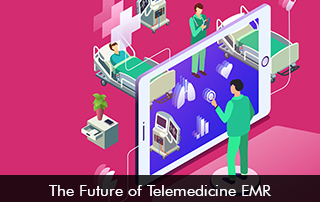The global COVID-19 pandemic caused many changes in all industries, especially healthcare. Due to the pandemic hospitals were overburdened, there were staff and provider shortages, and patients were advised to practice social distancing. Amidst this chaos, Telemedicine EMR Software came to the forefront of care. The virtual care solution helped patients receive remote diagnosis and treatment from the comfort of their homes and also increased care access at large.
The Increased Demand for Telemedicine Software
Before the pandemic, telemedicine software was not completely embraced by providers. It was an available option but was mostly not covered by insurers. Patients also had their inhibitions with telehealth.
The pandemic shaped an immediate demand for Telemedicine EMR Software solutions. Patients have been willing to use the robust platform for non-emergency issues, therapy sessions, chronic care management, and follow-up visits.
Healthcare providers have also shown a positive attitude toward telehealth – 80% of physicians have expressed that people have better care access through telemedicine EHR systems. Patients living in the outskirts can easily have quick access to specialists without having to travel.
Chronic Conditions and Telemedicine EMR System
Telemedicine video appointments are a great way to manage chronic conditions. An increase in chronic conditions is due to the aging population. The number of elderly patients continues to rise in the US. Chronic care specialists are using telehealth software to better treat and manage patients with chronic conditions.
Frequent check-ins due to telemedicine sessions, and the advancements in remote patient monitoring can aid providers in avoiding any adverse healthcare events. This has helped to enhance health outcome levels.
3 Key Trends Shaping the Future of Telemedicine Software
- 5G Technology Integration – The introduction of 5G technology will increase the telemedicine services’ dependability and speed, enabling faster data transfer, better video consultations, and a more seamless user experience.
- Enhanced Security Measures – With the increased use of telemedicine software systems, protecting patient data has become a primary responsibility. Telemedicine platforms are expected to have strong cybersecurity safeguards and follow tight compliance regulations, such as the Health Insurance Portability and Accountability Act (HIPAA) in the United States.
- Globalization – Telemedicine is gaining popularity worldwide, with more countries realizing its potential benefits. This development has the potential to improve international collaboration and standardization of telemedicine procedures. Building an ecosystem for healthcare that is more accessible and networked.
Telehealth Software Policy Changes
The COVID-19 public health emergency (PHE) resulted in a major telehealth expansion for Medicaid and Medicare enrollees in 2020, with waivers for more types of covered services issued.
Furthermore, to facilitate access, the U.S. Department of Health and Human Services (HHS) has relaxed licensure requirements for technological platforms to boost telemedicine adaptation.
The PHE for telemedicine is expiring on the 31st of December 2024, and a new bill has been introduced in January 2023. According to the new bill, there will be coverage offered for assistive telehealth consultations/sessions.
Many states including California and Georgia have recently updated telemedicine laws aiming to increase access to telehealth services. These laws establish payment parity for healthcare providers. This means that clinicians will be reimbursed at the same rate as in-person services.
Final takeaway
The future of telemedicine solutions depends upon coverage being permanent. The US continues to be the leading market for telehealth software.
Telehealth software will continue to boom as healthcare organizations and patients have realized its benefits even beyond the pandemic. Without compromising the overall standard of care, telemedicine can assist healthcare professionals in better meeting the requirements of their patients. The robust technology is abreast to address future healthcare needs.







